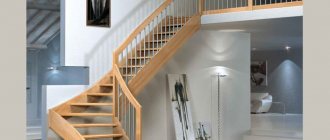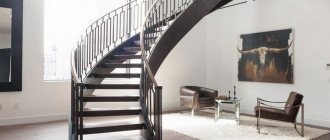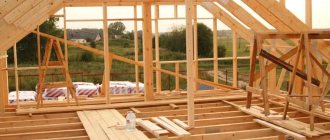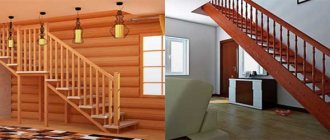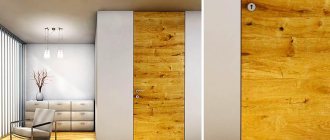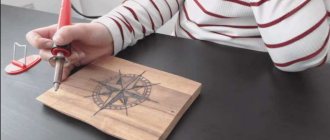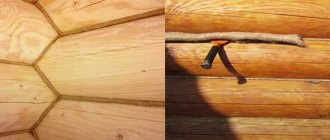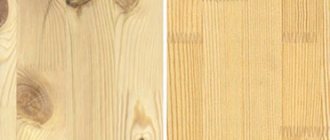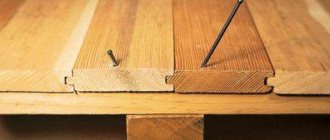Wood is most often used to make stairs in individual houses. The material is quite easy to process and can be given any shape. The surface retains its original properties for a long period. Flights of stairs usually occupy a central place in a building and serve as decoration for the premises. They are the main focus, highlighting, and coloring that can highlight the most effective elements.
Choosing methods for applying paint and varnish coatings, as well as coloring materials, is a rather interesting task. The paint for a wooden staircase is selected by the owner of the building and the performers.
Paint for wooden stairs
The need to paint the stairs
Reasons for painting include:
- Abrasion of an unprotected surface due to prolonged or frequent use;
- Even if you do not use the railings, the microclimate (air humidity, atmospheric parameters) in the room contributes to the exposure of the coating. Cracks may be visible. The material may dry out;
- Unsuitability of steps and frame, wear of elements;
- Beautiful design;
- Design update.
Constantly walking up stairs or using handrails leads to damage and peeling of wood or other material.
Varnish coating
Before varnishing, check on small fragments how a particular varnish behaves. Which shades are the most attractive?
The varnish is applied in cold and hot conditions. Some types penetrate better if they are preheated to a temperature of 50...60 ⁰C (alkyd and alkyd-urethane). Of course, the process becomes more complicated, but the penetrating abilities increase several times.
Some craftsmen do not heat the varnish; they heat the treated surface. You need to avoid overheating here. Do not allow boiling in the surface layer. Using a hair dryer, heating is carried out to a temperature of 60...75 ⁰С.
Varnishing is done with a brush, roller, swab or spray. Everyone may have their own preferences.
Attention! When varnishing, the room is closed from foreign objects and dust.
Most varnishes are harmful to the human body, so you need to follow safety precautions:
- use gloves;
- wear respirators that protect the respiratory system;
- use safety glasses if necessary.
The first stage of drying is carried out with doors and windows closed. Dust particles or insects can ruin the surface of the stairs. Only after drying until sticking stops can the room be opened so that solvent vapors can escape.
Requirements for processing spans
Any dye is slightly diluted. This consistency dries faster and spreads evenly over the coating.
The best effect appears after applying 2-3 layers. The painting tool also plays a big role.
The following requirements apply to the processing of spans:
- Wood in the house needs to be processed to a minimum. For example, it does not need to be primed before applying varnish. It is recommended to use hardwood, sanding the surface and staining it;
- The varnish can be matte (or semi-matte), glossy. Difference in light reflection. Glossy shine is not always appropriate in the house, but dullness emphasizes wood and its texture;
It is better not to take toxic-based materials or reagents with an unpleasant odor.
- It is more convenient to work when paint and varnish materials are purchased ready-made;
- With quick-drying dye, you need to work quickly, otherwise drips and sagging may remain.
Even if such seemingly insignificant moments are taken seriously, the staircase will decorate any room.
The best effect appears after applying 2-3 layers.
What problems arise during varnishing?
Applying paints and varnishes to wood is significantly different from coating metal. At the same time, processing pine has its own difficulties.
- Wood is hygroscopic. Varnish and paint are absorbed by the wooden surface.
- When varnishing, the top layer of wood is moistened. The result will be raised lint or a rough surface.
- Pine stands out for its resin content. The resin does not penetrate the material evenly. It is difficult to paint a resinous surface, and not all paint adheres. The varnish covers the surface of the pine unevenly. To hide such a defect, it is recommended to apply a dark varnish.
Useful video on the topic:
Requirements for coloring agents
If the staircase is made of expensive wood, then it is better not to paint over it, but to highlight it. The surface is first primed, then painted with paint with a low degree of coverage. To varnish wood, you can use clear or tinted varnish.
If the staircase is located inside the house, then it is more convenient and practical to use quick-drying products without a pungent odor, marked “odorless” or “eco-friendly”. The stairs to the attic are treated with durable paints or solvent-based varnishes.
The steps of the stairs are treated with abrasion-resistant material. Before purchasing any material, it is advisable to read the instructions and application rules.
If the staircase is made of expensive wood, then it is better not to paint over it, but to highlight it.
Shapes and sizes
Larch is a material that does not have a very low cost, so before manufacturing and installing a staircase, it is recommended to develop a project and accurately calculate the amount of wood required for the work. Otherwise, damaged and extra pieces of wood will increase the final cost. In addition, accurate calculation of dimensions will facilitate the assembly and installation of the finished product.
The staircase includes such elements as a landing, a step, a riser, a baluster, a bowstring and a handrail. All of them are basic components for any staircase. The material is divided into 2 grades: extra and A. They include solid-lamella and jointed boards, respectively.
Steps both from spliced larch and from solid larch most often have standard sizes: 40x300x1000, 1200x300x40, 40x600x1400, 40x600x1500 millimeters. There are corner and winder steps of the stairs. They are necessary for organizing turns. Such elements are located in the corner and have a diamond shape. They can be used instead of platforms, which saves space.
When creating a project and purchasing material, it is important to consider the required number of such elements. With an L-shaped staircase, you will need 1 corner and two winder steps. If you plan to install a U-shaped staircase, the number of steps increases. In this case, 2 corner and 4 winder elements will be required.
Products for painting wooden stairs
How to paint a wooden staircase in a house to the second floor? Options below...
Lucky
“Yacht” varnish is durable and easy to use. In particular, varnish with a matte composition is suitable for any coating, as it perfectly masks scratches and various defects. At the same time, the right varnish will highlight the texture of the rock.
Although oil varnishes weather quickly (they are made from sandarac and shellac), they are not moisture resistant. Many people prefer to use alkyd varnishes (outdoors too). Polyester varnishes are characterized by a shiny film, but polyurethane varnishes have a longer service life.
The right varnish will highlight the texture of the rock.
Paints
Paint not only protects the surface, but also gives the desired shade. Acrylic paint is water-based. It is reliable and easy to apply. Has the property of frost resistance. True, high moisture resistance.
If you want to use oil paint, you must use a respirator. The room must be ventilated, otherwise you can get toxic poisoning. Glossy compounds have increased slip properties. This is also important to consider.
Paint not only protects the surface, but also gives the desired shade.
Enamels
Enamel is similar to paint, but differs in composition. If you paint a wooden staircase with it, it will certainly shine. Special wood enamel is used exclusively inside the house. After application, drying is required for at least 72 hours.
The combination of two types of coatings looks beautiful: varnish and enamel of different shades. There are glyphthalic, oil, nitro enamels and other types of enamel.
Special wood enamel is used exclusively inside the house.
Impregnations
A type of impregnation is stain. It has an antiseptic effect. After treatment with stain, the wooden surface becomes non-flammable. When choosing it, it is worth remembering that the wood underneath darkens and acquires a rich shade. If a beginner is painting, then wax or oil impregnations would be the ideal option. Nitro-impregnations and alcohol impregnations are chosen by professionals in their work.
After treatment with stain, the wooden surface becomes non-flammable.
Why do you need to paint wood?
Wood is one of the most vulnerable building materials, so it needs additional protection. To protect a wooden porch from rotting and premature aging, special impregnations are used, as well as facade and finishing paints. The latter often contain the same substances as impregnations, and at the same time allow you to decorate the tree. Facade paints also perform the following functions:
- remove moisture from the wood and create a waterproof layer - thanks to this, microdestructions do not form in the material due to the expansion of water at low temperatures;
- protect the wooden porch from mechanical stress - the painted surface becomes harder and better protected from minor defects;
- protect wood from mold, fungal bacteria and insects - they are dangerous pests that significantly reduce the service life of wood products;
- emphasize the natural pattern of wood;
- Give a wooden porch any shade.
It should be kept in mind that there are a large number of different paints on the market today. Each of these mixtures has specific properties and is used differently depending on the purpose and type of wood. Therefore, before you start painting, you need to find a suitable paint coating.
Tips for choosing a coloring agent
To preserve the grain of the wood, you need to use a glossy varnish. For exterior work, solvent-resistant paints are needed. It is advisable to paint the steps with a composition that prevents evaporation. Enamel compounds help protect the wood.
If you have chosen a tinted varnish, then first the base should be painted dark. Any façade paint can be used to process wood. When choosing a shade of paint, you need to remember the style of the house so as not to spoil the wood.
It is advisable to paint the steps with a composition that prevents evaporation.
Recommendations for choosing colors
Light shades always look noble. The only thing is that they get more dirty. Dark colors look even darker in the twilight. In general, white marches and a dark floor look beautiful according to the classics. Another option: black, white and lilac with glitter? When painting, the type of wood is an important consideration.
How to paint a staircase in two colors? This can be solved by repainting the risers to match the color of the walls, and the steps to the color of the floors. Or you can change the color after one attack. Lots of options!
Light shades always look noble.
Treatment of softwood stairs
Before treating a staircase made of pine needles, it is better to remove the resin from it. If this is not done, the coloring composition will not be able to penetrate inside, and the resinous areas will darken. And paint does not adhere well to surfaces impregnated with resin. It’s a good idea to treat stairs with an acetone solution. Excessively tarred areas should be scraped off with a knife, and the recesses should be covered with putty.
Before treating a staircase made of pine needles, it is better to remove the resin from it.
Paint coating
For opaque finishes, pre-priming is used. Acrylic or alkyd primers will be very convenient here. They penetrate quite deeply into the wood and form strong adhesive bonds.
The subsequent paint will lie firmly on the surface.
Painting is done with a roller or brush. The roller makes it possible to quickly and evenly apply an even layer to steps and risers. A brush is convenient for painting balusters and railings.
For high-quality painting, the layer must be applied twice. The second painting is carried out only after the previous layer has completely dried.
What is the best way to paint a pine staircase?
How to paint a pine staircase in a house or country house? The best idea for painting a wooden staircase made of pine is alkyd/enamel paints, polyurethane varnishes. Defects in the pine material are hidden with thinned paint. Although the right one is expensive, it takes a long time. Acrylic paint can also work. It is fragrance-free and the tone can be mixed (this is even more interesting).
The best idea for painting a wooden staircase made of pine is alkyd/enamel paints, polyurethane varnishes.
Beautiful examples
- A larch staircase can be an excellent design option for a three-story house.
- Two-color staircase. To add zest, carved railings were used.
- Beautiful staircase made of larch. U-shaped option.
- L-shaped option.
- U-shaped staircase made of larch, made in two colors.
For an overview of the larch staircase, see the following video.
DIY staircase painting
How to paint a pine staircase with your own hands? It's possible! You just have to take into account some details and follow the step-by-step guide. If it seems that the task is impossible, then you can invite a construction company.
You will have to take into account some details and follow the step-by-step guide.
Preparatory work
If everything is decided, then feel free to get down to business:
- Remove all debris and dirt. Wash the stairs.
- Fill cracks and chips on the surface.
- Smooth out defects with sandpaper.
- Apply primer 2 times or stain 1 time.
- Mix the paint well
- Maintain room humidity.
If everything is decided, then feel free to get down to business.
Painting the stairs
To avoid inequality, a test sample is made on a waste board. How to paint a pine staircase (and not only) with your own hands? Falling out knots must be glued with epoxy glue. The primer is ideal for pine. It is important to sand the openings between layers. The gel stain has proven itself well.
To avoid inequality, a test sample is made on a waste board.
Variations of what color to paint a staircase in a wooden house
Each owner chooses the colors he likes. Preference is given to black and white variations (white oak), brown and cherry. You can do it in an original way: each step is painted in a new color or shade of color. Drawings can be painted on the steps in black, and the steps themselves can be light. Sometimes the amber color of the wood looks beautiful, and sometimes the color of mahogany. Some people like to match the color to the interior color of the room or style.
Each owner chooses the colors he likes.
Self-help errors
There is no need to immediately paint the stairs with expensive paint. To begin with, the coating is treated with an antiseptic or bleach. Railings and railings must be painted with UV-resistant material. Significant rookie mistakes:
- Incorrect application of products;
- Insufficiently prepared surface;
- Ignoring professional advice.
Railings and railings must be painted with UV-resistant material.
Expert advice
It is recommended to paint wooden stairs from top to bottom. Under no circumstances should you paint the stairs in sections. The highest quality coating is obtained when applied through a spray gun. To obtain a good varnished finish, it will not be enough to apply one coat of varnish.
It is recommended to paint wooden stairs from top to bottom.
If you approach the work correctly, the staircase in your house will look gorgeous! The most amazing thing is that you can do the work yourself, but take into account the advice. Good luck in your endeavors!
